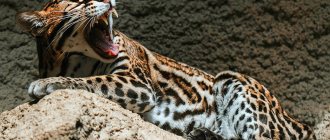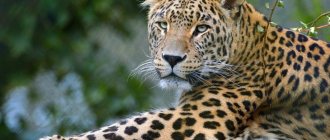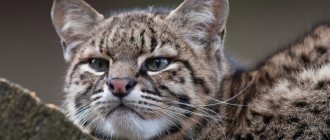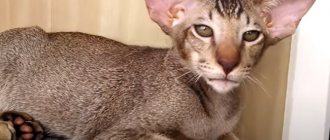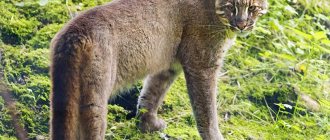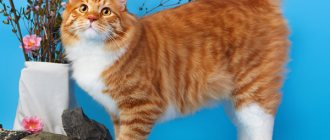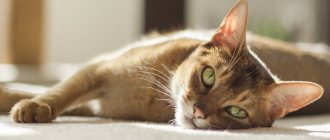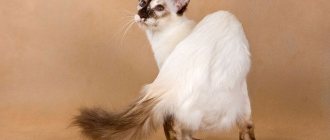08 April44050wild catscoeloppredator
Ocelot is a representative of the cat family, which is one of the most unusual and beautiful predators. At the same time, the ocelot cat is little studied. The ocelot animal is considered one of the brightest and most mysterious animals today. In this article you can see a description and photo of the ocelot, learn a lot of new and interesting things about the life of this exotic cat.
Scientific classification
- Kingdom: Animalia (animals)
- Phylum: Chordata
- Class: Mammalia (mammals)
- Order: Carnivora (predatory)
- Family: Felidae (felines)
- Genus: Leopardus (South American cats)
- Species: Leopardus pardalis (ocelot)
The name "ocelot" comes from the Nahuatl word "ocelotl", meaning "jaguar". Another source states that the name comes from the Latin word "ocellatus", meaning "eye", a reference to the shape of the spots on the ocelot's body.
Appearance and features
Photo: Ocelot animal
The ocelot's body is graceful, but strong and robust. The paws are solid and round, and the legs themselves are quite powerful and long. On the elongated neck there is a neat, slightly flattened head, on which widely spaced, rounded ears are clearly visible. The predator's eyes are very expressive, deep and slightly slanted. They are amber in color and stand out on the face with a bright black outline. The tip of the nose of these cats is pink.
The color of an ocelot's coat is a work of art. Perhaps, of all cats, he is the most beautiful and intricate. The main body tone is golden beige, the belly and the inside of the neck always have a lighter color. Bright spots (rosettes) throughout the body create a bizarre contrasting pattern.
The outline of the spots is very dark (almost black), and inside they have a lighter shade, which is darker than the main tone of the body, so it stands out beautifully against its background. Two bright dark stripes go up from the outlined eyes; the neck and cheeks of the ocelot are also beautifully lined. There are black specks everywhere on the paws. The tail of the predator is striped with a black tip.
Interesting fact: an ocelot's ears are black on top with a bright white spot in the middle, and white on the inside. From a distance, these spots on the ears can be mistaken for eyes, so scientists are divided on this feature. Some believe that it helps little kittens keep up with their mother by seeing her in front of them. Others argue that ocelots use these ear colors as a clever trick to fool other predators and mislead them.
The pattern located on the face and body may differ slightly in different subspecies of ocelot; in some cats, the entire background of the body has a grayish tint. Regardless of this, such a beautiful color of these amazing cats simply bewitches with its luxury and charm, captivating with its intricate magical and clear ornamentation.
Varieties
Scientists identify 11 subspecies of ocelot:
- Leopardus pardalis aequatorialis inhabits the northern part of the Andes;
- Leopardus pardalis albescens is native to Texas and Mexico;
- Leopardus pardalis maripensis lives in Guyana and Venezuela;
- Leopardus pardalis mearnsi is ubiquitous throughout almost all of Central America;
- Leopardus pardalis mitis occupies Argentine and Paraguayan lands;
- Leopardus pardalis nelsoni is of Mexican origin;
- Leopardus pardalis pardalis lives along the banks of the Amazon;
- Leopardus pardalis pseudopardalis calls Colombia its home;
- Leopardus pardalis puseaus is native to Ecuador;
- Leopardus pardalis sonoriensis lives in Mexico;
- Leopardus pardalis steinbachi inhabits Bolivian territory.
The ocelot also has two related species:
- The serval (Leptailurus serval) is an African relative of the ocelot;
- The fishing cat (Prionailurus viverrinus) is a wild cat native to the remote tropical forests and wetlands of Pakistan, India, Sri Lanka and Indonesia.
Geographical distribution
Photo: DEV Community
The ocelot can now be found in South and Central America, as well as along both coasts of Mexico, in the southern parts of the United States and on islands such as Trinidad or Margarita. The largest populations are found in Central America.
- Biogeographic regions: neotropical (native)
Habitat
The ocelot is adapted to a wide range of habitats, all of which have one thing in common - privacy and lack of open spaces. In Texas, the range is limited to dense forest and thorny brush along streams and rivers. In Arizona, a cat hides among the desert scrub vegetation. Further south in Mexico and Central America, the ocelot prefers coastal mangrove forests and swampy savannas. In South America it inhabits mainly tropical forests.
Photo: anthony_cout
Ocelots are also found in fields and sugar cane plantations. Although they are wild animals, they can sometimes be seen near populated areas. They live at altitudes of up to 1200 meters , although they were once seen at an altitude of 3800 meters!
- Terrestrial biomes: rainforest, savanna or grassland, peatland, mangrove, shrub desert
- Home range: 3.5-31 square kilometers
Natural enemies
In nature, the ocelot's enemies are larger food competitors: jaguars and pumas. Cubs and young animals can be attacked by caimans and some snakes (boa constrictors and anacondas).
Currently, the greatest threat to the species is not natural enemies, but a reduction in its habitat. The decrease in the area of tropical forests in South America occurs due to the systematic deforestation of forests without any planting of new trees, as well as as a result of natural causes: fires, hurricanes and flooding.
Character traits
Appearance
The ocelot is a small cat about the size of a lynx, but with dark spots. The body is compact and muscular. Both sexes are equally colored. The color of the coat depends on the environment in which the cats live. Forest-dwelling ocelots have yellowish or ocher fur, often tinged with cinnamon, while shrubby ocelots have greyish fur. Regardless of their habitat, their belly is white with black spots. And the fur itself is always silky smooth .
Photo: Caesar Kleberg
The ocelot's fur is decorated with irregular dark spots. Some of the dark spots have an elongated shape, more like stripes than spots. The patterns on the sides and back resemble rosettes, and the tail, paws and head are covered with dark stripes. The ocelot differs from the jaguar in being much smaller in size and having parallel black stripes on the back of the head and oblique stripes near the shoulder.
The tail is moderately long, edged with a black ring. The ears are dark, curiously pointed, covered with white spots. The eyes are brown ; when constricted, the pupils form spindle-shaped shapes. Since the ocelot is a predator, it has very strong paws with sharp claws.
Dimensions
Photo: Paul Donahue
The ocelot is the largest representative of South American cats. It is twice the size of a domestic cat, weighing up to 16 kg. Adult males can reach a body length of about 100 cm. The tail length sometimes reaches 45 cm. Females are usually smaller than males. They grow to a maximum of 93 cm and gain weight of about 10 kg.
- Body length: 68-100 cm
- Tail length: 26-45cm
- Shoulder height: up to 50 cm
- Body weight: 9-16 kg
- Average birth weight: 250 grams
Origin of the species and description
Photo: Ocelot
The ocelot is a not very large predator belonging to the cat family. Its name translated from Latin means “leopard cat.” The appearances of these animals are similar in many ways, the most significant difference between their appearance being their dimensions. There is another translation of the name “ocelot”; it comes from the language of the Aztec Indians and means “field tiger”, although this predator avoids settling in open spaces.
Not so long ago, scientists believed that felines appeared about 25 million years ago, however, at the dawn of the twenty-first century, another version was put forward regarding feline origin. Now experts claim that cats appeared precisely in Asian territory approximately eleven million years ago.
Video: Ocelot
The first to appear were large cats (of the panther genus), and then smaller ones, to which the ocelot is related. In general, among ocelots there are several subspecies that differ from each other, primarily in the place of their permanent location, but are almost identical in appearance.
To briefly describe the ocelot, we can call it something between a leopard and an ordinary cat. Compared to ordinary cats, it is quite large. A mature male reaches a length of more than a meter (130 cm), and a female reaches about 80 cm. The tail of ocelots is of considerable size - from 30 to 40 cm in length. The weight of males is about 15 kg, and females – 10.
This is a fairly powerful animal; for example, the shoulder width of an adult cat reaches half a meter. In terms of size, the ocelot can be compared to a large dog, such as a German shepherd. So, this cat is quite impressive in size.
Eating habits
The ocelot is a carnivore that tracks prey by smell. It feeds on a variety of small mammals and birds, as well as some reptiles, amphibians, crustaceans and fish. The menu of ocelots includes: guinea pigs, spider monkeys, parrots, opossums, armadillos, anteaters, agouti, iguanas, lizards, snakes, turtles. Large individuals can kill a small donkey or wild boar.
Sometimes wild cats make their way into agricultural lands, where they like to feast on young pigs, kids, lambs, and chickens. Rabbits, rats and mice of many species are important parts of their diet.
Characteristic
The largest of the small spotted cats, whose list includes Bengals , Toygers and Savannahs , the ocelot is one of the best-known and most widespread felid species in its range, as well as perhaps one of the most beautiful.
Externally, the animal is similar to a small leopard or a long-tailed cat, although it is larger than it, and smaller than a leopard.
Behavior
Photo: Ben
Ocelots are nocturnal and very territorial. They mark their territory with urine and guard it fiercely. Ocelots often fight each other to the death because neither opponent wants to give up.
These wild cats spend the day resting in trees and only go hunting at night. They must always be aware of other ocelots and predators because they themselves are easy prey . Even in leafy areas, ocelots move incredibly quietly thanks to the soft pads under their paws.
Excellent swimming skills are a characteristic feature that distinguishes ocelots from other cats (except jaguar and tiger).
Features of character and lifestyle
Photo: Ocelot animal
Ocelots prefer to live completely alone, forming pairs only for the mating period. They are sedentary animals with their own territories, the boundaries of which they carefully mark to avoid intrusion by strangers. The area of an adult male reaches 30 square kilometers; that of a female is half that size. Typically, the domain of one cat covers several plots of females.
Interesting fact: ocelots are excellent swimmers and climb not only trees, but also steep mountain slopes.
These miniature leopard-like creatures have excellent hearing, vision and sense of smell. Ocelots can communicate with each other using sounds. Sometimes they simply meow in their velvety cat melody, and during the wedding season they emit long, loud cries, looking for a lady of their heart. By nature, the ocelot is closed and secretive; it avoids people in every possible way, choosing impassable wild places for its life. These animals are very energetic and at the same time cautious; they try not to be an eyesore to other animals, hiding in dense growth.
Spotted predators go hunting at dusk, and in the light of the sun they cool down in shady thickets, on branches or deep tree hollows. The ocelot spends half the time of the day hunting, and he can travel considerable distances in search of prey, picking up the slightest sounds and vibrations of his potential victims, because the cat has a very highly sensitive hearing aid.
The ocelot's whiskers, like the strongest antennas, help it easily navigate any terrain and walk completely silently and gracefully, making its way through thickets and rock crevices. The lifespan of an ocelot living in the wild is about 14 years, and tamed individuals, with proper care, can live for a quarter of a century.
Those ocelots that live at home are quite smart, active and have a playful character. Their entertainment is somewhat reminiscent of dog games, they love to carry and retrieve a ball in their teeth, walking on a leash does not bother them at all, ocelots love to swim in a pool or any other body of water. But establishing strong friendships with other pets is very rare for an ocelot, because by its cat nature it is very independent and does not like competition.
Breeding season
Photo: rancholaspalomas
Ocelots live solitary lives and never mate except during mating season. Females become sexually mature by the age of 2, but they can become pregnant only at 3.5 years and are able to reproduce until they are 13 years old. Males become sexually mature at approximately 2.5 years. The mating season for ocelots usually lasts 4 months, from October to January.
The female often plucks her belly fur to make a nest for her kittens. The lair is located in the thickest part of the thicket. The gestation period is 75 days, after which two cubs are usually born, with a maximum of 4 kittens. The female has only two pairs of nipples (a domestic cat has four), so she will not be able to feed more kittens.
Like other feline cubs, they are blind at birth and covered with scanty hair. The young open their eyes only 15-18 days after birth. Over the next two years, the female teaches her kits the techniques of hunting so that they can begin to live independently and go in search of their territories.
- Mating system: polygamy
- Breeding interval: every two years
- Number of offspring: from 1 to 4 cubs
- Gestation period: 2.5 months
- Weaning time: 6-7 weeks
- Age of sexual or reproductive maturity: 22 months (females), 30 months (males)
Purchasing a kitten
The best option for purchasing an ocelot is from nurseries that specialize in the special cultivation of this species. The specificity is that, ideally, a kitten for home should be weaned from its mother at 1-2 weeks and hand-fed. This is done so that the baby perceives the person as an integral part of his life and subsequently can settle down in the new home as a pet, and not as a resident of the enclosure, who can attack in moments of bad mood.
The price of an ocelot cat depends on the level and reputation of the nursery, because the more money and effort the breeder invests in the kittens, the more docile they grow. A kitten from a bona fide breeder costs $15,000 - $20,000; such a baby must have the entire package of documents, certificates of origin, as well as a veterinary passport. If you buy a kitten from a cattery from the USA, then the cat itself will cost $10,000 - $15,000, but if you are a risky person and don’t have enough adventures in your life, then you can buy a semi-wild ocelot in South America for $500.
IMPORTANT: in Russia, an ocelot is considered the same as keeping a wild animal, so be sure to check all permitting documents for the kitten, otherwise you will face the confiscation of your pet and a fine for illegally keeping a wild animal.
Ocelots as pets
Wild cats are often kept by people as pets. This also applies to the ocelot. Salvador Dali himself often traveled with his ocelot named Babu, even when traveling abroad.
Photo: The Great Cat
“Domestic Ocelots” is the name given to the Ocicat cat breed, which is a cross between the Abyssinian cat, the Siamese cat and the American Shorthair cat. Their originally colored fur resembles the fur of a wild ocelot, and the behavior of the animal gives the impression that this is a real South American wild cat.
Hybrids
Ocelots can interbreed with other members of the cat family, producing offspring with common species characteristics. The most famous hybrid is the marlo: the baby of a male margay and a female ocelot. In 2007-2008, the first attempts were made to breed three-component hybrids by crossing Bengal cats and ocelots. Artificial hybrids also include the Ocicat, bred by crossing a wild dwarf leopard and a domestic cat.
In some sources you can find mention of the pumelot (a hybrid of a puma and an ocelot), but there is no confirmed data on the crossing of species in natural conditions.
PUMA
Save Status
Ocelot hunting was very popular in the 1960s and 1970s. In those days, about 200 thousand individuals died annually. Their skins are very valuable , and their fur is in demand in the clothing market. In subsequent years, people also began stealing young ocelots from their lairs to sell as pets.
Photo: City of Albuquerque
Although ocelots are still abundant in parts of Mexico and Central and South America, the current ocelot population consists of fewer than 100 individuals .
Overhunting and habitat destruction have significantly reduced the range and numbers of ocelots in Texas. Landscape changes during the twentieth century as a result of mechanical farming and deforestation fragmented the wildcat's range and created barriers to the dispersal of populations between South Texas and northern Mexico.
Ocelots are currently protected in the United States by the Endangered Species Act and worldwide by the Convention on International Trade in Endangered Species of Wild Fauna and Flora. But despite the ban on the trade in ocelot skins, they are still killed en masse.
An ocelot skin is known to be worth US$40,000 . With such demand, illegal poaching is likely to continue despite efforts to enforce restrictions. But as more people become aware of the shortage of small spotted cats in the wild, fur sales are facing growing social hostility that is dampening the fashion for cat skins.
- IUCN Status: Least Concern
- Red Listed in the United States: March 28, 1972
- Threats: poaching, habitat loss
Life in captivity
Sometimes ocelots are kept at home, like ordinary domestic cats. It is difficult to purchase an ocelot; its price can reach 15–20 thousand dollars. However, if a person decides to make such a purchase, he will need to provide the cat with all the necessary conditions.
It will be difficult for a person to create suitable conditions for keeping a wild cat
The first thing the owner of a domesticated predator should remember is the ocelot mode. The cat will sleep during the day and hunt at night. It is difficult to force an ocelot to change these principles, this is how his nature works. It should also be understood that the ocelot is a proud animal, it cannot be offered “some” conditions, it will only be able to behave well if it is kept in an ideal manner.
It will be difficult to keep a large wild cat in an apartment. An animal needs a lot of space to play, run and express its hunting instincts. Of course, plenty of space and fresh air are very similar to the animal's natural habitat. But in most regions of Russia the climate is cool. Therefore, if we are talking about a private house, then in the enclosure you can install a heated shelter for the cat. And in winter, even such a shelter will not save the heat-loving predator from the Russian cold (the cat will need to be kept at home). The enclosure itself must be well fenced, safe, and must contain elements reminiscent of a wild environment (trees, snags, grass, stones, etc.).
If you do not give the ocelot a suitable and spacious place, the animal may become depressed or sick. If the owner tries and does everything at the highest level, the cat will not be in debt. There are many stories about how the ocelot became tame and affectionate, like an ordinary pet.
Video: ocelot communicates with its owner
Features of ocelot care
An ocelot kept in an apartment will run across sofas, tables and cabinets. The size of the cat will not allow this to be done gracefully, so the owner needs to immediately remove everything that breaks. In order for an animal to become tame and docile, it must be raised methodically and from early childhood. It needs to be petted, it needs to be played with while sitting on the floor, it needs to be hand-fed, etc. However, even if these conditions are met, the ocelot still needs the street. If the cat owner does not have his own area, then the ocelot can be walked like a dog. Of course, this requires a collar and a strong leash. Leash training needs to be done from a very young age.
You can't hit a jungle cat; he might harbor a grudge. All attempts on the part of a person to “reason” with a stupid animal will be perceived as aggression, and this will interfere with the educational process. This cat needs toys. Small balls intended for indoor cats are not suitable (the cat may swallow them). The ocelot needs toys of the size that are sold for dogs.
Neighborhood with other animals in the apartment is unlikely to be possible. In addition, the smaller the other pet, the more likely it is to be eaten. On the other hand, large animals (for example, dogs) may be perceived as rivals for territory. They won't be able to be friends anyway. When it comes to children, things are even more complicated. Ocelots are afraid of children, so they will try to hide in corners, closets, etc. And if a child inadvertently offends the animal, it may scratch or even bite.
The ocelot's animal instincts remain even when he gets into a person's house
Unlike some domestic cats, ocelots are easily litter trained. The cat needs to be immediately shown where to go to the toilet and where not to go. For the convenience of the animal (and so that you do not have to frequently wash near the potty), the tray should be purchased taking into account the size of the animal. For such large cats, litter trays designed for dogs or large cats (such as Maine Coons) are suitable. The correct choice of tray also determines whether the house will smell.
The smell of a cat in the house may also be due to the fact that the animal has begun to mark its territory. To prevent this from happening, it is advisable to castrate the ocelot in childhood (from 6 months). Of course, this is provided that the cat is not kept in a nursery (zoo) and is not threatened with mating. It is also advisable to vaccinate your animal. The owner can consult a veterinarian about vaccinations. The main thing is that the vaccine must not be live.
The owner of an American cat should also know that each individual must have documentation. This is a mandatory condition for keeping wild animals listed in the Red Book. If the owner does not have documents on purchase, the ocelot will be considered purchased illegally (from hand). Such an animal can be seized without the consent of the owner. The animal will end up in a zoo or be released into its native environment, and the owner will be subject to administrative punishment.
In our city (Penza), the discovery of rare animals in someone’s home becomes real news. If the owner of the animal does not have documents, then such an event is called a crime and is covered on all local television channels. I believe that such examples should encourage future owners of ocelots to legally purchase them.
the owner of the ocelot must have documents confirming the purchase of the animal
What to feed your pet ocelot
The ocelot's diet should be close to natural. Most of the diet should consist of protein foods. Feral cats are usually given meat, but offal is also suitable. The meat can be beef, veal or poultry. Pork is a prohibited type of meat. The volume of the daily diet is determined based on the cat’s body weight (3–5% of meat by weight). If an ocelot weighs 10 kilograms, then it should receive at least 300–500 grams of fresh meat.
An important requirement for meat is that it must have bones. Therefore, sometimes offal is even better than pulp, for example, beef. Chicken by-products (necks, wings, etc.) contain many small bones, so this bony food most closely resembles the usual food of ocelots. However, the menu should be varied. It is recommended to alternate these products.
I have friends who keep a wild cat at home (although it comes from Africa). Any wild animals should be fed raw meat. Indeed, at first they only bought fresh beef and veal for that cat. Over time, friends began to understand that it would be very difficult to maintain such a diet. Now they buy broiler carcasses from the poultry farm's wholesale warehouse. They had to purchase a separate freezer, but the manufacturer gives a good discount. Chicken meat costs my friends the price of offal.
In addition to protein food, your cat can be given seafood or dry cat food. Wild cats are not prone to obesity, so the cat will not overeat in any case. If possible, you can purchase food mice or rats. This option is the most favorable, but such products can be difficult to obtain. With proper care and feeding, an ocelot can live up to 25 years in a home environment.
Video: Ocelot of the Novosibirsk Zoo
Did you know?
- The lifespan of ocelots is 12-15 years (20 years in captivity).
- Juveniles often become prey for boa constrictors, pumas, jaguars, anacondas, caimans and South American harpies.
- This is the only cat that sleeps like a dog. He curls up and puts his head on his hind legs.
- The Moche people of pre-Columbian Peru worshiped ocelots, and their depiction can often be found in Peruvian art.
- The ocelot is an excellent climber, able to scale a tree in a matter of seconds.
- The ocelot swallows food in chunks because it cannot chew. Before eating a bird, he plucks it with his teeth and paws.
- There are currently up to 1.5 million ocelots in the world.
- Every day, ocelots cover a distance of up to 11 kilometers.
Nutrition
In nature, the hunting objects of these predatory mammals are small animals, birds, fish and amphibians. Of the representatives of South American fauna, the most common animals that cats eat for lunch are rodents, armadillos, and even large insects. Brazilian representatives of the species feed on small monkeys, while Mexican representatives feed on iguanas. The main criterion when choosing prey is weight and size. Typically, animals are content with prey weighing up to 1 kg, especially since this is the amount of food a cat needs to meet its daily need for proteins and fats.
In many ways, the diet depends on the time of year. For example, during periods of drought, Venezuelan cats eat rodents and lizards, and when there is heavy rainfall, they eat land crabs.
In general, the tastes of Ocelots are not too different from the eating habits of representatives of related species of the cat family. Oncillas usually choose birds and arboreal marsupials, and Margay is not particularly picky in its choice of food.
Developed senses help seals find prey: a keen sense of smell, night vision, and acute hearing. The predator lies in ambush not far from the prey and waits for the prey to lose its vigilance. If the object of the hunt manages to escape, the hunter changes his location. The cat kills a caught animal or bird by tearing its throat with its teeth and immediately eats it, biting off large pieces. The predator pre-plucks the feathered prey.
If it is impossible to profit from game or meat, the cat goes to the nearest body of water to search for fish or reptiles.
